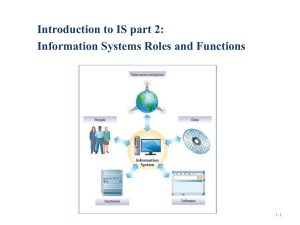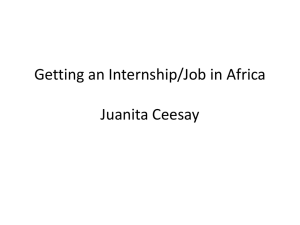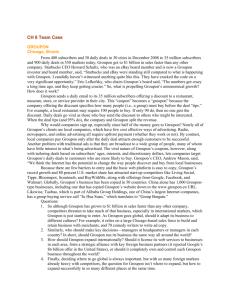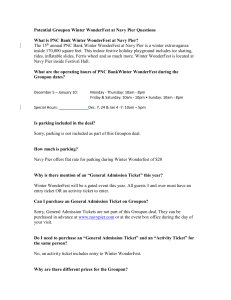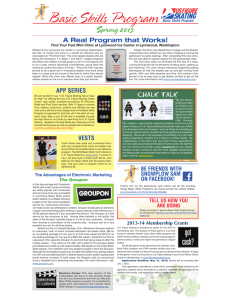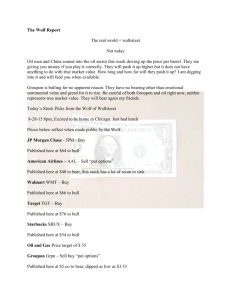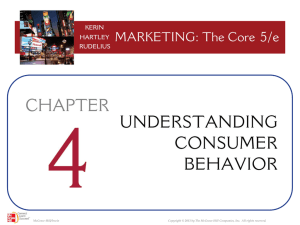Groupon, Inc. (GRPN) Memo
advertisement
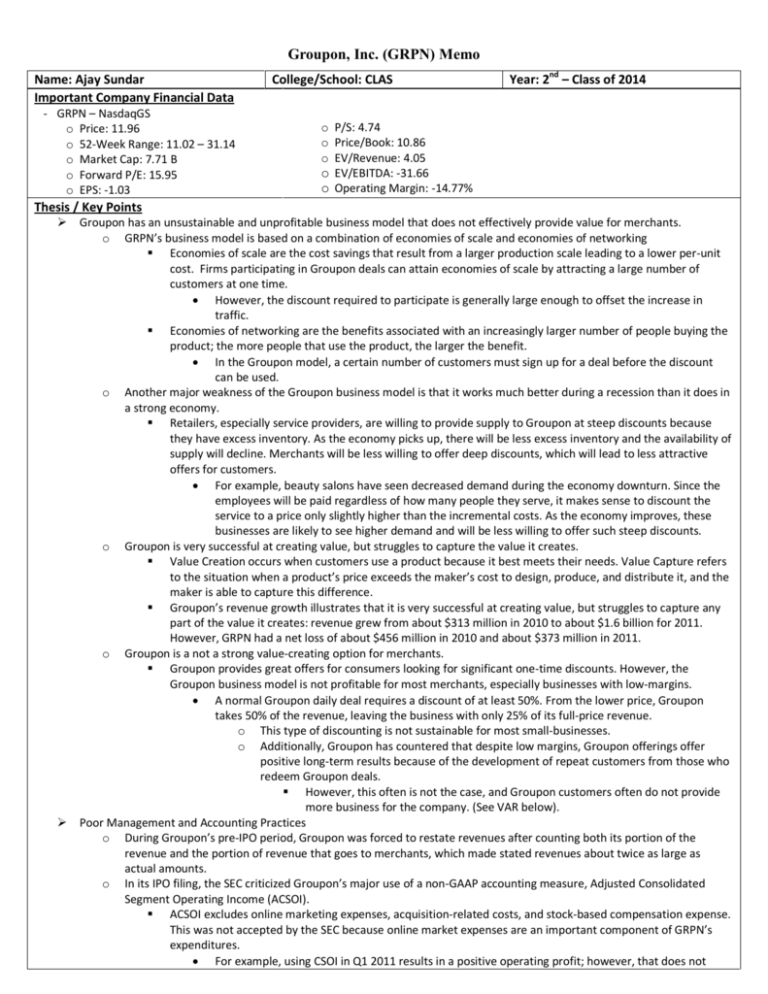
Groupon, Inc. (GRPN) Memo Name: Ajay Sundar Important Company Financial Data - GRPN – NasdaqGS o Price: 11.96 o 52-Week Range: 11.02 – 31.14 o Market Cap: 7.71 B o Forward P/E: 15.95 o EPS: -1.03 College/School: CLAS Year: 2nd – Class of 2014 o P/S: 4.74 o Price/Book: 10.86 o EV/Revenue: 4.05 o EV/EBITDA: -31.66 o Operating Margin: -14.77% Thesis / Key Points Groupon has an unsustainable and unprofitable business model that does not effectively provide value for merchants. o GRPN’s business model is based on a combination of economies of scale and economies of networking Economies of scale are the cost savings that result from a larger production scale leading to a lower per-unit cost. Firms participating in Groupon deals can attain economies of scale by attracting a large number of customers at one time. However, the discount required to participate is generally large enough to offset the increase in traffic. Economies of networking are the benefits associated with an increasingly larger number of people buying the product; the more people that use the product, the larger the benefit. In the Groupon model, a certain number of customers must sign up for a deal before the discount can be used. o Another major weakness of the Groupon business model is that it works much better during a recession than it does in a strong economy. Retailers, especially service providers, are willing to provide supply to Groupon at steep discounts because they have excess inventory. As the economy picks up, there will be less excess inventory and the availability of supply will decline. Merchants will be less willing to offer deep discounts, which will lead to less attractive offers for customers. For example, beauty salons have seen decreased demand during the economy downturn. Since the employees will be paid regardless of how many people they serve, it makes sense to discount the service to a price only slightly higher than the incremental costs. As the economy improves, these businesses are likely to see higher demand and will be less willing to offer such steep discounts. o Groupon is very successful at creating value, but struggles to capture the value it creates. Value Creation occurs when customers use a product because it best meets their needs. Value Capture refers to the situation when a product’s price exceeds the maker’s cost to design, produce, and distribute it, and the maker is able to capture this difference. Groupon’s revenue growth illustrates that it is very successful at creating value, but struggles to capture any part of the value it creates: revenue grew from about $313 million in 2010 to about $1.6 billion for 2011. However, GRPN had a net loss of about $456 million in 2010 and about $373 million in 2011. o Groupon is a not a strong value-creating option for merchants. Groupon provides great offers for consumers looking for significant one-time discounts. However, the Groupon business model is not profitable for most merchants, especially businesses with low-margins. A normal Groupon daily deal requires a discount of at least 50%. From the lower price, Groupon takes 50% of the revenue, leaving the business with only 25% of its full-price revenue. o This type of discounting is not sustainable for most small-businesses. o Additionally, Groupon has countered that despite low margins, Groupon offerings offer positive long-term results because of the development of repeat customers from those who redeem Groupon deals. However, this often is not the case, and Groupon customers often do not provide more business for the company. (See VAR below). Poor Management and Accounting Practices o During Groupon’s pre-IPO period, Groupon was forced to restate revenues after counting both its portion of the revenue and the portion of revenue that goes to merchants, which made stated revenues about twice as large as actual amounts. o In its IPO filing, the SEC criticized Groupon’s major use of a non-GAAP accounting measure, Adjusted Consolidated Segment Operating Income (ACSOI). ACSOI excludes online marketing expenses, acquisition-related costs, and stock-based compensation expense. This was not accepted by the SEC because online market expenses are an important component of GRPN’s expenditures. For example, using CSOI in Q1 2011 results in a positive operating profit; however, that does not Groupon, Inc. (GRPN) Memo account for $179.9 million in marketing expenses, which led to an operating loss of $117.15 million. o More recently, Groupon had another accounting controversy when it was forced to lower revenue for 4Q 2011 by $14.3 million and net income by $22.6 million, which changed GRPN’s 2011 results to a larger net loss of $64.9 million on a lower revenue of $492 million. These revisions were attributed to an increase number of returns of Groupon purchases, especially of the larger-ticket items, like Lasik procedures, to which Groupon has been transitioning. These types of returns are hard to forecast, and will likely lead to future difficulty in calculations for Groupon. The SEC is examining Groupon’s revision of its financial results. While the examination is still at a preliminary stage, it could lead to a formal investigation of the issue. This revision has also led to a shareholder lawsuit, in which an investor claims the company overstated revenue, issued materially false and misleading financial results, and concealed how its business was not growing as fast and was not nearly as resistant to competition as it had suggested. Many other similar suits were filed, and now a class-action lawsuit has been filed, which could be damaging for Groupon, even if the case is settled. The daily-deal sector has expanded exponentially and Groupon faces increased competition. o When Groupon began, it was the only major player in the daily-deals industry. Now, GRPN faces intense competition from companies like LivingSocial, Angie’s List (“The Big Deal”), Google Offers, and AmazonLocal. o Another important factor is that there are extremely low barriers to entry in the daily-deals industry. Between May 2010 and May 2011, the number of competitors increased 529% to 482 companies. o David Reibstein, a Marketing professor at Wharton, says, “However brilliant of an idea it is, there is also now a huge increase in competition. When Groupon had few competitors, it was more viable than it is now with 499 competitors.” o Another concern is companies like Google have increased negotiating power and have more of an ability to absorb the huge marketing costs required to continually attract new customers, while also beginning with a larger user base. Misperception - Groupon creates value for merchants – This is NOT true o An initial attraction of Groupon was the potential to create repeat customers from customers who purchased a Groupon to try something for the first time. However, as seen through VAR (see Exhibits section), this has not been the case, especially because most of Groupon’s customers are “deal-prone customers,” or price-sensitive customers. o Merchants will soon discover (if they have not already done so) the Groupon customers are not the target group for building future business and loyal, repeat customers. o If merchants do create a Groupon offering, the above facts illustrate that it will likely be a one-time use of Groupon done only to create a stronger brand presence. - Since its IPO, Groupon has been increasing its international presence in the daily-deal industry with acquisitions – This is NOT true o Other the purchase of Mertado, Groupon has stayed away from increasing its international presence in the daily-deal industry. Instead, its acquisitions have been focused on companies that will increase its online community and commerce abilities. VAR Please see Exhibits section How It Plays Out I believe that consumer sentiment will stay low for Groupon in the short-term, causing the share price to decline slightly or stay near its current levels. If a potential SEC investigation takes place, it will represent a strong catalyst. Other catalysts will include the proceedings of the aforementioned lawsuits and potential settlements. During the revision of 2011 financial results, GRPN did reaffirm its projections for Q1 2012. Exceeding analysts’ expectations will lead the stock price higher. However, on June 1, the lockup period for selling shareholders will come to an end. I foresee this as another strong catalyst that will lead Groupon’s stock price lower. Risks / What Signs Would Indicate We Are Wrong? If Groupon is able to transition to higher-priced, higher-margin product deals successfully, this would lead to Groupon being a better value proposition for merchants, and would lead to increased demand. If Groupon Now! (Groupon 2.0 – a mobile app that would display all local deals available in an area) becomes more successful and after initial struggles, the platform has seen improved results – Groupon may have found another revenue stream. If Groupon expands its presence internationally, it could take advantage of a huge, untapped market in the daily-deals industry. However, to expand overseas, Groupon would need to spend significantly on international advertising. Groupon’s name recognition and strong brand make it an attractive acquisition target. Google offered $6 billion for Groupon in December 2010, and offers at much higher valuations are possible in the future. Signposts / Follow-Up Rate of return for customers to come back to a business (currently only 1 in 5). Product mix of Groupon offerings – higher priced, higher margin vs. lower-price, low-margins Return reserve as a % of revenue (see exhibits) Proceedings of lawsuit and SEC examination. Company Description GRPN operates as a local commerce marketplace that connects merchants and customers by offering popular attractions, goods, and services at significant discounts. The company allows customers to purchase these daily-deals through email alerts, or through the company’s website or mobile app. Founded in 2008, Groupon is headquartered in Chicago and currently employs over 11,000 employees. Groupon, Inc. (GRPN) Memo VAR - For my VAR, I talked to merchants who were offering or had previously used Groupon to create a daily-deal offering. I spoke to the following merchants: o James River Reeling and Rafting – Water Sports company located in Scottsville, VA. Offered Groupon of $46 for a Day of River Tubing for Four, a $92 value. o The Murder Mystery Company – an interactive mystery troupe located in Denver, CO. Offered Groupon of $29 for a 3-course dinner and show (with options for groups of 2 or 4), a $60 value. o Emilio’s – a Spanish restaurant located in Richmond, VA. Offered Groupon of $15 for $30 of food and drinks. - I asked the following questions and received the corresponding responses: 1. What led your company to create a Groupon offering? o James River: First time user, we wanted to expand our customer base and potentially reign in new clients. o Murder Mystery: We figured it out money wise then created a public show that would fit. Groupon sells well, so we created a business that would work with it. Short answer…to make money. o Emilio’s: Wanted to bring in business and increase sales. 2. Did you find that using Groupon created value for your business - did sales jump after using Groupon or did the discount required for the offering offset the increase in traffic? o James River: The discount is definitely going to offset traffic. The goal primarily was to expand to new customers. o Murder Mystery: We make money on the Groupon, but if I was a sandwich shop I'd never use them. People that buy from them always want a discount. Them coming back and paying full price is an urban legend. o Emilio’s: No, no jump in sales; employees hate it. 3. Did you find that customers who redeemed their Groupon continued to come back and become regular customers? o James River: Still too early to tell as most of the Groupon users have not redeemed their promo but hopefully so. o Murder Mystery: People that buy Groupons can become loyal Groupon re-buyers, which works fine for me. o Emilio’s: No return customers. They just want free stuff and don't want to actually spend money. 4. Would you use Groupon again? Why or why not? o James River: If we find that Groupon (after the season is over) does not increase our repeat business of new customers through the 2013 season then, no, we will not be using the service again. o Murder Mystery: We've done about 50 Groupons and have had amazing success. It's made me rich(ish). I'll run them until they become MySpace then I'll use LivingSocial. o Emilio’s: Hell no, it's a huge hassle. o This information shows that Groupon does not create value for merchants, and that most small businesses will use Groupon once, at most, only in order to increase brand recognition. While it may be an effective tool for higher-margin companies like The Murder Mystery Company, many of its most popular deals are for businesses such as restaurants, which struggle to generate profits from Groupon offerings. - Chart 1: Quarter-over-Quarter Revenue Growth o This chart shows the quarter-over-quarter revenue growth for Groupon has been slowing down since its peak in Q3 2010. One reason for the slowed growth could be reduced marketing spending, which leads to the acquisition of fewer new customers for Groupon. Marketing spending had been declining for Groupon; however, the amount was larger in Q4 2011 than in Q3, which may have led to the increase in quarterly revenue growth from Q3 to Q4. Another reason for the decline could be increased competition, especially from sites like LivingSocial, Google Offers, and AmazonLocal. Groupon, Inc. (GRPN) Memo - Chart 2: Quarterly Growth in Groupon’s Sold o Another consequence of Groupon’s reduced marketing spending and increased competition in the daily-deals industry is that quarterly growth in the number of Groupon’s sold has been steadily declining. This is not a positive sign because this means that growth is slowing even in new international markets, which sugggests GRPN will have to continue to spend significant amounts on marketing if they hope to keep customer and unit sales growth strong. - Groupon Accounting Explanation o The main reason for Groupon’s earnings restatement earlier this year, and one its biggest accounting issues, deals with returns and refunds. This is easiest to explain with an example: o Assume Groupon sells 500 deals for $40 each, for a total of $20,000. The Groupons expire in 6 months. As per usual, Groupon keeps 50% of these revenues and gives 50% to the merchant ($10,000 each). However, the merchant only gets 1/3 of the revenues initially, another 1/3 after one month, and the final third after two months. The merchant may not get the full $10,000 if there are people who are not eligible for the Groupon and qualify for a full refund. Assume that there 50 people who qualify for refunds within 60 days of purchase. Groupon will refund a total of $2,000, holding $1,000 from the merchant’s portion of revenues. This means that the merchant’s final payment is $2,333. After 60 days have passed (and before 6 months), however, there is a change in the above reasoning. The merchant has been paid the full amount, but the Groupon Promise states that Groupon will still refund anyone who is deemed as ineligible for the offer. If another 50 people are ineligible, Groupon now has to pay the entire refund amount itself. This amounts to another $2,000 in refunds paid by Groupon. o So, after the deal expires: 500 Groupons were sold, for a total of $20,000. One hundred Groupons have been refunded, which brings revenues to $16,000. However, the merchant has received $9,000 in revenues, while Groupon retains only $7,000. This changes the revenue split to 56.3/43.7 in favor of the merchant, rather than the original 50/50 split. This problem is further exacerbated if there are more returns after the merchant’s two-month payment period or if the price of the refunded product is higher – if there are enough returns, Groupon could even lose money on an offering. o But, Groupon recognizes the entire $10,000 as revenue as soon as it is received, minus an expected number of refunds. However, the model Groupon uses to predict the number of refunds has not been accurate, as the company’s product mix has changed and the number of deals sold increases. Essentially, Groupon is not exactly sure how much revenue they will receive. Groupon, Inc. (GRPN) Memo o The Refunds Reserve was actually a smaller percentage of revenue in 2011 than in 2010, showing the Groupon’s estimations are not very accurate. This also indicated that Groupon perhaps should not recognize revenue immediately, as poor calculation of refunds claimed led to a misstatement of earnings. These calculations and revenue recognition approach are the primary causes for the SEC examination. - Table 1: Comparables -based Valuation P/S Price/Book EV/Revenue OPEN 6.68 8.52 6.32 LNKD 20.60 17.05 19.49 TZOO 2.65 10.17 2.33 PCLN 8.12 13.74 7.64 Mean 5.82 10.81 5.43 *Excluded LNKD because metrics seemed to be outliers, even considering the small sample size GRPN EV Using Comps Using P/S: P/S Multiple 5.82 GRPN Sales 1,610,000,000.00 Implied EV 9,370,200,000.00 Subtract Debt 0.00 Add Cash 1,120,000,000.00 Equity Value 10,490,200,000.00 Shares Outstanding 644,840,000.00 Implied Share Price 16.27 EV/Revenue EV/R Multiple GRPN Revenue Implied EV Subtract Debt Add Cash Equity Value Shares Outstanding Implied Share Price Using Price/Book P/B Multiple 10.81 GRPN Book Value 699,470,000.00 Implied EV 7,561,270,700.00 Subtract Debt 0.00 Add Cash 1,120,000,000.00 Equity Value 8,681,270,700.00 Shares Outstanding 644,840,000.00 Implied Share Price 13.46 5.43 1,610,000,000.00 8,742,300,000.00 0.00 1,120,000,000.00 9,862,300,000.00 644,840,000.00 15.29 o I believe that part of the reason for the higher implied prices is that it is difficult to find truly comparable public companies for Groupon. Most of its main competitors are private companies, such as LivingSocial, Rue La La, or the Gilt Groupe, or are parts of much larger companies like Google or Amazon. o Additionally, this price takes into account the catalysts of a potential SEC investigation, lawsuit proceedings, or insider selling (once the lockup period ends on June 1st). -
